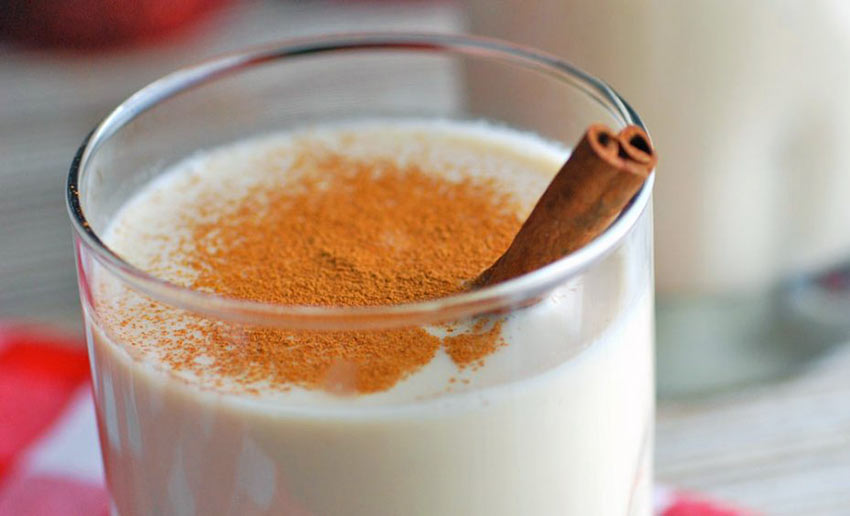Bored of eggnog? Sick of cider? Here are nine scrumptious winter beverages to sip on from across the globe
Courtesy Lila Thulin, smithsonianmag.com
In the United States, the winter months might conjure the image of a crackling fire, wrapping paper, lit candles and the taste of warm cider, eggnog or piping-hot chocolate. These libations — iced, boozy or once-a-year delicacies — reflect the culinary traditions, weather, religion and agriculture of the places they originated. Here are nine beverages that will be served at special occasions around the globe this winter.
Cola de Mono — Chile

Hailing from the northern stretches of Chile, this drink incorporates the flavors of cinnamon, cloves, vanilla, coffee and sometimes citrus into its milky base. A Chilean spirit called aguardiente made from grape residue (for those outside of South America, substitute pisco, brandy or rum) adds an alcoholic zip. The drink traditionally gets prepared the day before it’s served, chilled, to ward off the December heat in the Southern hemisphere. The story behind the spiked coffee drink’s name remains somewhat murky, but the most common version involves Pedro Montt, who served as president of Chile in the early 20th century. According to two variants of the origin story related by folklorist Oreste Plath, cola de mono — “tail of the monkey” in Spanish — comes from Montt’s nickname among friends (“El Mono”) and, depending on which tale you subscribe to, either an inventive ice cream shop owner whose concoction comforted Montt after an electoral defeat or a late-night party where Montt brought along his Colt revolver.
Coquito – Puerto Rico

“If I go through a Christmas and I haven’t tasted coquito, it’s not Christmas,” says Roberto Berdecia, co-founder of the San Juan bars La Factoria, JungleBird and Caneca. Coquito, a cold, coconutty cousin to eggnog, is a fridge staple throughout the island’s long holiday season, which Berdecia explains starts essentially the day after Halloween and lasts until San Sebastián Street Festival fills its namesake street with art and revelry in mid-January. Most families have a passed-through-the-generations recipe, but basic ingredients include coconut cream, three types of milk (evaporated, condensed, coconut), rum (Berdecia prefers gold rum, but the drink can be made with white rum or whatever’s on hand), and cinnamon and nutmeg for flavor. At Puerto Rican holiday gatherings with family and friends, the “little coconut” drink gets raised up for toasts — ¡Salúd! — and served cold, either on the rocks or sans ice.
Here’s a recipe published in the Washington Post and developed by Alejandra Ramos, who runs a food blog called “Always Order Dessert.”
Kompot – Ukraine, Russia, Poland, other Slavic countries
Think jam, but drinkable: kompot, an Eastern European drink, comes from boiling fresh or dried fruits (depending on seasonal availability) with water and sugar until the fruits’ flavor suffuses the drink. “Kompot is essentially a non-carbonated and non-alcoholic juice made with real fruit,” explains Natasha Kravchuk, a Boise-based food blogger who immigrated to the U.S. at age four from Ukraine and shares recipes on her website, “Natasha’s Kitchen.” The exact taste, Kravchuk says, changes depending on the types of fruit used and how heavy-handed the cook is with the sugar, and the fruity beverage can be ladled up cold or warm, depending on whether the weather’s frosty or scorching.
Natasha’s kompot recipe strains the fruit out, but others, like this one from Kachka: A Return to Russian Cooking author Bonnie Frumkin Morales, keep the boiled fruit in. In Poland, kompot has a place among the twelve dishes traditionally served for Wigilia, the Christmas Eve dinner.
Sorrel – Jamaica

This deep-red drink comes in slightly different forms — bissap in Senegal (the drink’s roots lie in West Africa), for instance, and agua de Jamaica in Spanish-speaking countries in and near the Caribbean. In Jamaica, sorrel punch became a Christmas drink because it was during the last months of the year when hibiscus, the signature ingredient of the drink, grew, as Andrea Y. Henderson reports for NPR. Served cold, sorrel punch has notes of cinnamon, sometimes a kick from rum or wine, and other times hints of ginger or mint. One crucial ingredient for sorrel, however, is time; the flavor intensifies the longer it sits. NPR has sisters Suzanne and Michelle Rousseau’s sorrel recipe, excerpted from their cookbook Provisions: The Roots of Caribbean Cooking.

Tusu Wine – China
This medicinal rice wine has had a place in Chinese customs since at least the fourth and fifth centuries C.E., according to the National Palace Museum in Taiwan. The name tusu is said to reference the drink’s ability to protect the drinker from ghosts. Traditionally, on New Year’s Day in China (Chinese New Year, not January 1), a family will drink tusu, imbibing in order of age, youngest to oldest, as a way to jointly wish for their relatives’ health in the coming year. This ritual departs from typical Chinese drinking customs, as a family’s eldest members usually take the first sips of a beverage. Janet Wang, author of The Chinese Wine Renaissance: A Wine Lover’s Companion, tells Smithsonian that the preparation of tusu wine is similar to mulled wine; the base rice wine is simmered with spices. The herbal blend for tusu varies regionally, Wang explains, but frequently includes pepper, cinnamon, atractylodes (a sunflower relative), Chinese bellflower, rhubarb and dried ginger. The tusu-maker would place the herbs in a red pouch for luck, soak them in a well overnight, cook the herbs with the wine and serve the resulting tusu still steaming. But you won’t have much luck finding tusu wine at a market, even in China — it “is really a historical tradition that is still preserved only in small local pockets.” In Japan, the drink is called o-toso, says Wang, adding that “tusu wine” is now a catch-all term for any old wine enjoyed for the Chinese New Year.
Palm Wine – Nigeria, Western Africa and Other Regions
In Western Africa, being a palm tree tapper is a full-time job. Palm wine, extracted from various species of palm trees by cutting into the tree and letting its sap drip and accumulate, has long been a celebratory drink of choice in Nigeria. The “milky and powerfully sweet” beverage, as Atlas Obscura’s Anne Ewbank describes it, ferments quite rapidly thanks to naturally occurring yeast. Within hours of tapping, it reaches four percent alcohol content — the tipsy-making potential of a light beer. Soon after that, it’s fermented to the point of becoming vinegar. Palm wine goes by many names, among them emu, tombo and palmy, and often plays a role in Igbo and Yoruba weddings. “Since Christmas is an adopted holiday,” Nigerian chef Michael Adé Elégbèdé, who trained at the Culinary Institute of America and runs a test kitchen called ÌTÀN in Lagos, tells Smithsonian, “we don’t have specific food traditions affiliated to it other than the same dishes and drinks people would have generally for celebratory purposes.” Palm wine, he offers up, is a year-round festive delicacy. Because of palm wine’s blink-and-you’ll-miss-it shelf life, in-store varieties can be hard to come by on the other side of the Atlantic, but here’s a recipe for another popular Nigerian adult beverage, the sangria-esque Chapman.
Sujeonggwa – Korea
Another fruit-based beverage, sujeonggwa gets a kick from the cinnamon, fresh ginger and dried persimmons with which it’s brewed. The drink has been around for about a millennium, and for the last century or so, it’s been linked to the New Year, according to the Encyclopedia of Korean Seasonal Customs. Koreans serve this booze-free “cinnamon punch” at the end of a meal, sprinkled with pine nuts and sometimes other touches like citrus peel or lotus petals. Here’s a recipe from YouTube Korean cooking guru Maangchi.
Salep – Turkey

Over 100 species of orchid grow in Turkey, and a large portion of those flora can be transformed into the principle ingredient for salep. When harvested, boiled and ground up, the flower turns into a flour that thickens a milk-and-spice (often cinnamon, rosewater and pistachios, per Atlas Obscura) brew. You can buy the toasty drink from stands in the streets of Istanbul, at least for now — environmentalists warn that orchid harvesting poses a major threat to wild orchid populations. Genuine salep powder might prove tricky to track down outside of Turkey, but glutinous rice flour or other starch can stand in while whipping up a batch. Özlem Warren, author of Özlem’s Turkish Table, shares her recipe here.
Poppy Seed Milk – Lithuania
In Lithuania, Christmas Eve steals the show. Families feast on 12 dishes — 12 for the number of Jesus’s apostles and the number of months in a year — that avoid using meat, dairy or alcohol. (The dietary restrictions stem from the bygone tradition of pre-Christmas fasting, as Lithuania is majority Catholic.) Along with herring and mushrooms, aguonų pienas, or poppy seed milk, has a place at that night-before-Christmas table, where empty dishes are set out for recently departed relatives. To make poppy seed milk, says Karile Vaitkute, who immigrated to the U.S. from Lithuania 25 years ago and now edits the Lithuanian Museum Review, one first takes poppy seeds (a garden bounty in her home country) and scalds them in close-to-boiling water. Then the cook pulverizes the poppy seeds using a mortar and pestle, meat grinder or other tool. “It starts giving you this whitish water, and that’s why it’s called milk,” Vaitkute explains. Sugar or honey lends the unstrained drink some sweetness. The lactose-free “milk” often accompanies crispy Christmas poppy seed biscuits known as kūčiukai. Here are recipes for both the milk and cookies from Draugas News.

























